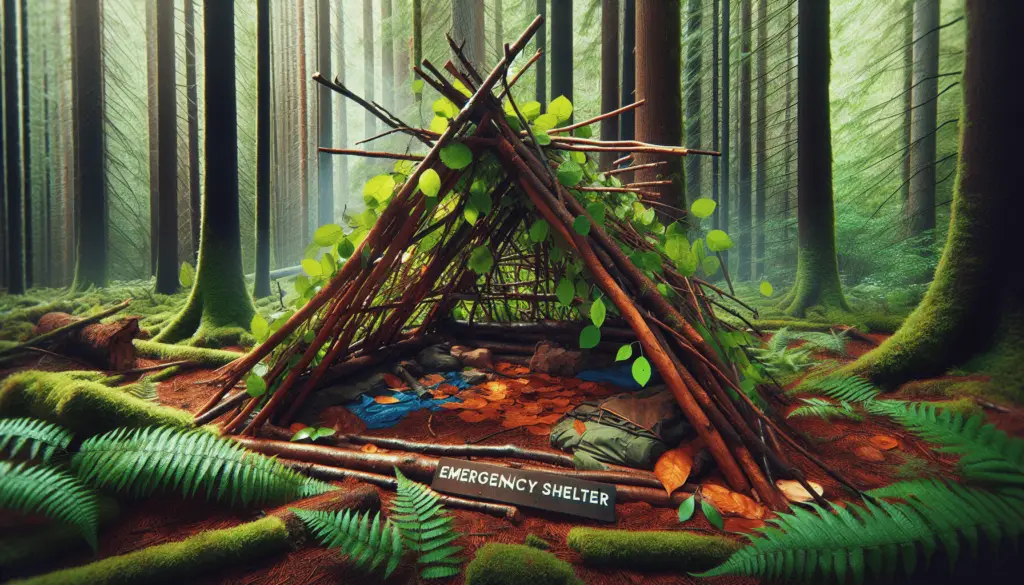Welcome to this guide on how to build an emergency shelter using natural materials! When the unexpected happens, it’s essential to know how to create a safe haven with materials found in the environment. In this article, you will learn how to construct a sturdy and reliable shelter that can provide protection in emergency situations. From choosing the right location to selecting the best natural materials, you will be equipped with the knowledge to build a shelter that can withstand the elements and keep you safe. Stay tuned to discover the steps to creating your own emergency shelter with natural materials. Have you ever found yourself in a situation where you needed to build an emergency shelter with limited resources? Whether you’re stranded in the wilderness, facing a natural disaster, or simply looking to hone your survival skills, knowing how to construct a shelter using natural materials can be a lifesaving skill. In this article, we will guide you through the process of building an emergency shelter with materials found in nature. From selecting the right location to constructing a sturdy shelter, we’ve got you covered. Let’s dive in and explore the art of survival shelter building!

Choosing a Suitable Location
When it comes to building an emergency shelter, your choice of location is crucial. Ideally, you want to find a spot that offers protection from the elements, such as wind, rain, and extreme temperatures. Look for a flat area that is not prone to flooding and is a safe distance away from any potential hazards, such as falling rocks or unstable trees.
What to Consider When Choosing a Location
When selecting a location for your emergency shelter, keep the following factors in mind:
- Proximity to water source: Ensure that your shelter is close to a source of water for drinking and other essential needs.
- Visibility: Choose a spot that is easily visible to rescuers or passersby, but not so exposed that it puts you at risk.
- Natural barriers: Look for natural features, such as boulders or dense vegetation, that can provide additional protection from the elements.
Remember, the key to building a successful emergency shelter is to balance protection and accessibility.
Collecting Natural Materials
Once you have chosen a suitable location for your emergency shelter, it’s time to gather the materials you will need to construct it. The beauty of building a shelter with natural materials is that you can find many of the essentials right in your surroundings. Look for items such as branches, leaves, vines, and rocks that can be used to create a sturdy and insulated shelter.
Essential Materials for Building an Emergency Shelter
Here are some of the key materials you will need to gather for your shelter:
- Branches: Use branches of varying sizes to create a frame for your shelter and provide structural support.
- Leaves: Collect leaves, pine needles, or other foliage to create a waterproof and insulating layer for your shelter.
- Vines or rope: Use vines or rope to lash together branches and secure your shelter’s structure.
- Rocks: Use rocks to anchor down your shelter and provide stability in windy conditions.
By collecting these natural materials, you can ensure that your emergency shelter is strong, durable, and able to withstand the elements.
Building a Simple Lean-to Shelter
One of the easiest and most effective types of emergency shelters to construct is a lean-to shelter. This simple shelter consists of a slanted roof supported by a frame of branches. A lean-to shelter can provide protection from rain, wind, and sun, making it an ideal choice for a variety of survival scenarios.
Step-by-Step Guide to Building a Lean-to Shelter
Follow these steps to construct a basic lean-to shelter using natural materials:
- Find a sturdy tree or other support for the back wall of your shelter.
- Lean branches of varying lengths against the support to create a slanted roof.
- Weave smaller branches or vines through the roof structure to provide stability.
- Cover the roof with a layer of leaves or foliage to create a waterproof barrier.
- Use rocks or logs to anchor down the corners of your shelter and secure it in place.
With these simple steps, you can build a reliable lean-to shelter that will keep you safe and dry in the wilderness.
Constructing a Debris Hut Shelter
Another type of emergency shelter that is easy to construct with natural materials is a debris hut shelter. This type of shelter consists of a framework of branches covered with layers of leaves or other foliage. A debris hut shelter can provide excellent insulation and protection from the elements, making it a popular choice for survival situations.
Step-by-Step Guide to Building a Debris Hut Shelter
Follow these steps to construct a debris hut shelter using materials found in nature:
- Create a frame for your shelter by leaning branches against a central support.
- Layer branches and leaves on top of the frame, starting from the bottom and working your way up.
- Continue adding layers of debris until the shelter is completely covered and insulated.
- Leave a small opening at one end of the shelter for ventilation and entry/exit.
- Use extra branches or rocks to secure the shelter and prevent it from collapsing.
With a debris hut shelter, you can stay warm and protected from the elements while waiting for rescue or navigating the wilderness.

Improving Shelter Insulation and Waterproofing
To ensure that your emergency shelter provides maximum protection from the elements, it’s important to focus on insulation and waterproofing. By adding extra layers of leaves, foliage, or other debris to your shelter, you can increase its insulating properties and keep heat trapped inside. Additionally, using a thick layer of leaves or pine needles on the roof of your shelter can create a waterproof barrier that will prevent leaks and keep you dry during rainstorms.
Tips for Improving Shelter Insulation and Waterproofing
Here are some tips to enhance the insulation and waterproofing of your emergency shelter:
- Gather as many leaves and foliage as possible to create a thick layer on the roof and walls of your shelter.
- Use larger branches or logs to create a raised platform for your shelter, which can help insulate from the cold ground.
- Dig a shallow trench around your shelter to divert rainwater away and prevent flooding inside.
By focusing on insulation and waterproofing, you can significantly increase the comfort and effectiveness of your emergency shelter.
Building a Survival Shelter with Found Objects
In some situations, you may not have access to an abundance of natural materials to build a shelter. In these cases, it’s important to get creative and use found objects or debris to construct a survival shelter. By repurposing items such as tarpaulins, plastic sheeting, or even clothing, you can quickly create a temporary shelter that will protect you from the elements.
Tips for Building a Survival Shelter with Found Objects
Here are some tips for building a survival shelter using found objects and debris:
- Look for discarded materials, such as plastic sheeting or tarps, that can be used as a quick and easy shelter cover.
- Use rocks, logs, or other heavy objects to anchor down the edges of your shelter and prevent it from blowing away.
- Fill any gaps or holes in your shelter with leaves, branches, or clothing to increase insulation and waterproofing.
By improvising and adapting to your surroundings, you can build a functional survival shelter even with limited resources.
Final Thoughts
Knowing how to build an emergency shelter with natural materials is a valuable skill that can save your life in a variety of survival situations. By choosing a suitable location, collecting essential materials, and following step-by-step instructions for construction, you can create a sturdy and protective shelter using items found in nature. Whether you opt for a simple lean-to shelter, a debris hut shelter, or a makeshift shelter using found objects, the key is to use your creativity, resourcefulness, and ingenuity to stay safe and secure in the wilderness. So, next time you find yourself facing an emergency situation, remember these tips and techniques for building a survival shelter with natural materials. Your ability to adapt and thrive in challenging conditions may just be the key to your survival. Stay safe, stay prepared, and happy shelter building!
